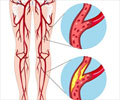Patients with peripheral artery disease (PAD) and depressive symptoms experience worse recovery especially women, compared to counterparts without depressive symptoms.

‘Integrating mental health screening and treatment pathways into chronic disease management may increase the opportunity to improve outcomes.’
Read More..




"This is the first study to document how depressive symptoms may complicate PAD recovery even among patients receiving specialty care," said senior study author Kim G. Smolderen, Ph.D., FAHA, a clinical health psychologist and co-director of the Vascular Medicine Outcomes Research Program in the internal medicine department at Yale New Haven Hospital, Yale University School of Medicine in New Haven, Connecticut. Read More..
For one year, researchers followed 1,243 patients treated at vascular specialty clinics in the U.S., the Netherlands and Australia who were being treated for new or recurrent symptoms of PAD. Patients included in the study (average age 67, 38% women) were enrolled from the Patient-centered Outcomes Related to Treatment Practices in Peripheral Artery Disease Investigating Trajectories (PORTRAIT) Registry.
The international registry addresses gaps in knowledge about the quality of care and health outcomes of patients with PAD, especially as seen from the patients' perspectives.
Researchers assessed depressive symptoms at the beginning of the study using the standard 8-item Patient Health Questionnaire (PHQ-8). Patients rated statements about how often they:
Advertisement
The researchers then reconstructed the one-year health status trajectory by whether or not patients reported depressive symptoms when they were diagnosed with PAD. The analysis found:
Advertisement
"A major goal of PAD treatment is improving patients' health status and quality of life," said study first author Qurat-Ul-Ain Jelani, M.D., an interventional cardiologist in training at Yale University School of Medicine. "Not recognizing or treating depressive symptoms may stand in the way of realizing optimal recovery.
"As more value-based care options are designed for patients with PAD, integrating mental health screening and treatment pathways into chronic disease management may increase the opportunity for patients to receive more holistic care, thus improving outcomes. A multidisciplinary approach that includes mental health supports for patients with PAD would be beneficial."
Because the study was focused on patients treated at vascular specialty clinics, the findings may not be representative of the general PAD population who may not have access to specialty care. Researchers also acknowledged that the emphasis on depressive symptoms excludes many mental health concerns, such as anxiety or stress, and also excludes unmeasured clinical factors that could contribute to depressive symptoms.
"PAD is more than treating the legs and the corresponding pain," Smolderen said. "We need awareness for the patient as a whole in order to provide patient-centric care."
Source-Eurekalert












